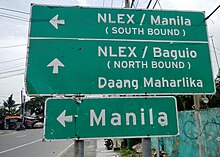

Road signs in the Philippines are regulated and standardized by the Department of Public Works and Highways (DPWH). Most of the signs reflect minor influences from American and Australian signs but keep a design closer to the Vienna Convention on Road Signs and Signals, to which the Philippines is an original signatory. The Philippines signed the convention on November 8, 1968, and ratified it on December 27, 1973.
Though the Philippines has signed the Vienna Convention on Road Signs and Signals, road signs "Priority Road", "End of priority road", "Give way to oncoming traffic" and "Priority over oncoming traffic", which are mainly found in European countries, are not used in this country as well as in the United States, Canada, and Latin American countries.
Part 2 of the Highway Safety Design Standards Manual mandates the use of the Standard alphabets, often referred to as Highway Gothic. It contains a reproduction of the former Australian implementation AS1744-1975 Standard Alphabets in the appendix pp A103-A146. Clearview appears to have supplanted it, and other fonts are in use.
Regulatory signs
Regulatory signs indicate the application of legal or statutory requirements. Disregarding these signs may constitute the road user to an offense.
Priority signs
Directional signs
-
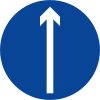 No turns
No turns
-
 One way (right)
One way (right)
-
 One way (left)
One way (left)
-
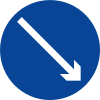 Keep right
Keep right
-
 Keep left
Keep left
-
 Pass either side
Pass either side
-
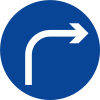 All traffic (right)
All traffic (right)
-
 All traffic (left)
All traffic (left)
-
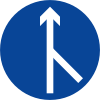 Merging traffic
Merging traffic
-
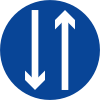 Two-way traffic
Two-way traffic
-
 No turns (plate type)
No turns (plate type)
-
 One-way (right, plate type)
One-way (right, plate type)
-
 One-way (left, plate type)
One-way (left, plate type)
-
 Keep right (plate type)
Keep right (plate type)
-
 Keep left (plate type)
Keep left (plate type)
-
 All traffic (right, plate type)
All traffic (right, plate type)
-
 All traffic (left, plate type)
All traffic (left, plate type)
-
 Merging traffic (plate type)
Merging traffic (plate type)
-
 Two-way traffic (plate type)
Two-way traffic (plate type)
-
 Salubong na Trapiko (Two-way traffic)
Salubong na Trapiko (Two-way traffic)
-
 Right lane must turn right
Right lane must turn right
-
 Left lane must turn left
Left lane must turn left
Restrictive signs
-
 No entry for all vehicles
No entry for all vehicles
-
 No entry for all vehicles (plate type)
No entry for all vehicles (plate type)
-
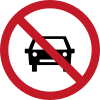 No entry for cars
No entry for cars
-
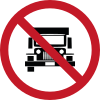 No entry for jeepneys
No entry for jeepneys
-
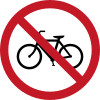 No entry for bicycles
No entry for bicycles
-
 No entry for motorcycles
No entry for motorcycles
-
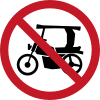 No entry for tricycles
No entry for tricycles
-
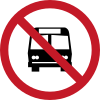 No entry for buses
No entry for buses
-
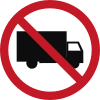 No entry for trucks
No entry for trucks
-
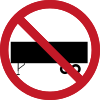 No entry for vehicles with trailer
No entry for vehicles with trailer
-
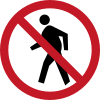 No pedestrian crossing
No pedestrian crossing
-
 No entry for animal drawn vehicles
No entry for animal drawn vehicles
-
 No entry for pushcarts
No entry for pushcarts
-
 No crossing, use overpass (plate type)
No crossing, use overpass (plate type)
-
 No pedestrian crossing (plate type)
No pedestrian crossing (plate type)
-
 Bawal tumawid, gamitin ang overpass (No crossing, use overpass) (plate type)
Bawal tumawid, gamitin ang overpass (No crossing, use overpass) (plate type)
-
 No right turn
No right turn
-
 No right turn (plate type)
No right turn (plate type)
-
 No left turn
No left turn
-
 No left turn (plate type)
No left turn (plate type)
-
 No U-turn
No U-turn
-
 No U-turn (plate type)
No U-turn (plate type)
-
 No overtaking
No overtaking
-
 Bawal lumusot (No overtaking) (plate type)
Bawal lumusot (No overtaking) (plate type)
Speed signs
Parking signs
-
 No parking
No parking
-
 Bawal pumarada (No parking)
Bawal pumarada (No parking)
-
 No parking, loading only
No parking, loading only
-
 No parking anytime
No parking anytime
-
 No parking, tow-away zone
No parking, tow-away zone
-
 Time restricted parking
Time restricted parking
-
 Time restricted parking
Time restricted parking
-
 Loading zone
Loading zone
-
 Loading and unloading zone
Loading and unloading zone
-
 No waiting anytime
No waiting anytime
-
 No waiting
No waiting
-
 Bawal maghintay ano mang oras (No waiting anytime)
Bawal maghintay ano mang oras (No waiting anytime)
-
 No loading and unloading anytime
No loading and unloading anytime
-
 Bawal magsakay at magbaba (No loading and unloading)
Bawal magsakay at magbaba (No loading and unloading)
-
 No loading unloading anytime
No loading unloading anytime
-
 No stopping anytime
No stopping anytime
-
 No parking, public utility bus stop
No parking, public utility bus stop
-
 No parking, public utility jeepney stop
No parking, public utility jeepney stop
-
 No parking, public utility jeepney stop
No parking, public utility jeepney stop
-
 Do not block intersection
Do not block intersection
-
 Right turners cross at broken white lines
Right turners cross at broken white lines
Miscellaneous signs
-
 No blowing of horns
No blowing of horns
-
 Width restriction
Width restriction
-
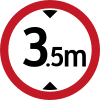 Height restriction
Height restriction
-
 Weight restriction (by tonnes)
Weight restriction (by tonnes)
-
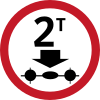 Weight restriction (per axle)
Weight restriction (per axle)
-
 Length restriction
Length restriction
-
 End of all restrictions
End of all restrictions
-
 Fasten seatbelt
Fasten seatbelt
-
 Pedestrian crossing
Pedestrian crossing
-
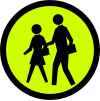 Children crossing
Children crossing
-
 Bicycles lane
Bicycles lane
-
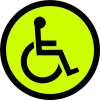 Persons with disabilities crossing
Persons with disabilities crossing
Warning signs
Warning signs are used to warn road users to the potential hazard along, or adjacent to, the road. They are triangular and red-bordered, similar to warning signs used in Europe.
Horizontal alignment signs
-
 Sharp turn (right)
Sharp turn (right)
-
 Sharp turn (left)
Sharp turn (left)
-
 Reverse turn (right)
Reverse turn (right)
-
 Reverse turn (left)
Reverse turn (left)
-
 Curve (right)
Curve (right)
-
 Curve (left)
Curve (left)
-
 Reverse curve (right)
Reverse curve (right)
-
 Reverse curve (left)
Reverse curve (left)
-
 Winding road (right)
Winding road (right)
-
 Winding road (left)
Winding road (left)
-
 Hairpin bend (right)
Hairpin bend (right)
-
 Hairpin bend (left)
Hairpin bend (left)
Intersection and junction signs
-
 Intersection
Intersection
-
 Staggered intersection (right)
Staggered intersection (right)
-
 Staggered intersection (left)
Staggered intersection (left)
-
 Skewed intersection (right)
Skewed intersection (right)
-
 Skewed intersection (left)
Skewed intersection (left)
-
 T-junction
T-junction
-
 Y-junction
Y-junction
-
 Half Y-junction (right)
Half Y-junction (right)
-
 Half Y-junction (left)
Half Y-junction (left)
-
 Reverse half Y-junction (right)
Reverse half Y-junction (right)
-
 Reverse half Y-junction (left)
Reverse half Y-junction (left)
-
 Side junction (right)
Side junction (right)
-
 Side junction (left)
Side junction (left)
-
 Roundabout
Roundabout
-
 Priority, side junction (right)
Priority, side junction (right)
-
 Priority, side junction (left)
Priority, side junction (left)
-
 Priority, merging traffic (right)
Priority, merging traffic (right)
-
 Priority, merging traffic (left)
Priority, merging traffic (left)
-
 Priority, intersection
Priority, intersection
Advance warning of traffic control devices signs
Road width signs
-
 Narrow bridge
Narrow bridge
-
 Narrow bridge (plate type)
Narrow bridge (plate type)
-
 Road narrows
Road narrows
-
 Road narrows (plate type)
Road narrows (plate type)
-
 Start of divided traffic
Start of divided traffic
-
 End of divided traffic
End of divided traffic
Road obstacle signs
-
 Opening bridge
Opening bridge
-
 Uneven road
Uneven road
-
 Hump
Hump
-
 Steep descent (right)
Steep descent (right)
-
 Steep descent (left)
Steep descent (left)
-
 Steep climb (right)
Steep climb (right)
-
 Steep climb (left)
Steep climb (left)
-
 Spill way
Spill way
-
 Flood
Flood
-
 Falling debris (right)
Falling debris (right)
-
 Falling debris (left)
Falling debris (left)
-
 Slippery road
Slippery road
-
 Mag-ingat, madulas ang kalsada (Slippery road) (plate type)
Mag-ingat, madulas ang kalsada (Slippery road) (plate type)
-
 Cattle crossing
Cattle crossing
-
 Low flying aircraft
Low flying aircraft
Pedestrian signs
-
 Pedestrian crossing ahead
Pedestrian crossing ahead
-
 Slow down, pedestrian crossing ahead (plate type)
Slow down, pedestrian crossing ahead (plate type)
-
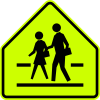 Children crossing ahead
Children crossing ahead
-
 Cross only at pedestrian crossing
Cross only at pedestrian crossing
-
 Handicapped crossing
Handicapped crossing
-
 Bike lane ahead
Bike lane ahead
Railroad crossing signs
-
 Railroad crossing position
Railroad crossing position
-
 Railroad crossing advance warning (unsignalled)
Railroad crossing advance warning (unsignalled)
-
 Railroad crossing advance warning (signalled)
Railroad crossing advance warning (signalled)
-
 Railroad crossing position (alternative)
Railroad crossing position (alternative)
Supplementary signs
-
 Advisory speed
Advisory speed
-
 On side road (right)
On side road (right)
-
 On side road (left)
On side road (left)
-
 Distance (meter)
Distance (meter)
-
 Distance (kilometer)
Distance (kilometer)
-
 Next distance (kilometer)
Next distance (kilometer)
-
 When wet
When wet
-
 Blind
Blind
-
 Aged
Aged
-
 Playground
Playground
-
 School
School
-
 Disabled
Disabled
-
 For public utility jeepneys
For public utility jeepneys
-
 For buses
For buses
Other warning road signs
-
 Vertical clearance
Vertical clearance
-
 Low clearance
Low clearance
-
 Slow down, accident prone area
Slow down, accident prone area
-
 Bumagal, madalas ang aksidente dito (Slow down, accident prone area)
Bumagal, madalas ang aksidente dito (Slow down, accident prone area)
-
 Slow down, merging traffic ahead
Slow down, merging traffic ahead
-
 Lane ends, merge left
Lane ends, merge left
-
 Slow down, weighbridge ahead
Slow down, weighbridge ahead
Guide or information signs
Guide or information signs are used to inform road users about the direction and distances of the route that they are following.
Advance direction signs
-
 Stack direction (multiple)
Stack direction (multiple)
-
 Stack direction (single)
Stack direction (single)
-
 Stack direction (with road name)
Stack direction (with road name)
-
 Diagrammatic direction
Diagrammatic direction
-
 Diagrammatic direction (roundabout)
Diagrammatic direction (roundabout)
Intersection direction signs
-
 Intersection direction (right)
Intersection direction (right)
-
 Intersection direction (left)
Intersection direction (left)
-
 Intersection direction (both sides)
Intersection direction (both sides)
-
 Intersection direction (with road name)
Intersection direction (with road name)
Reassurance direction signs
Finger board and direction signs for less important roads
Street signs
Town names and geographical feature signs
Service signs
-
 Service sign (with name of service, symbols, and distance)
Service sign (with name of service, symbols, and distance)
-
 Service sign
Service sign
-
 Service sign
Service sign
-
 Service sign
Service sign
-
 Service sign (advance sign with name of service)
Service sign (advance sign with name of service)
Tourist information and tourist destination signs
-
 Tourist spot Fort Santiago
Tourist spot Fort Santiago
-
 Tourist spot Taal Lake
Tourist spot Taal Lake
-
 Tourist spot National Museum turn right
Tourist spot National Museum turn right
-
 Tourist spot scenic lookout on right
Tourist spot scenic lookout on right
Route marker signs
-
 National Route marker
National Route marker
-
 Expressway Route marker
Expressway Route marker
-
 Route markers
Route markers
-
 Route markers
Route markers
-
 Route markers
Route markers
-
 Route markers
Route markers
-
 Route markers
Route markers
-
 Route markers
Route markers
-
 Route markers
Route markers
-
 End
End
Asian highway route marker signs
-
 Asian highway marker
Asian highway marker
-
 Asian highway segments
Asian highway segments
-
 Asian highway segment
Asian highway segment
-
 Asian highway maintenance jurisdiction
Asian highway maintenance jurisdiction
-
 Asian highway segment name
Asian highway segment name
Expressway signs
Expressway signs are signs that are used on, or near, controlled-access roads.
Expressway approach signs
Expressway information signs
-
 Prohibited on expressway
Prohibited on expressway
-
 Bawal pumasok sasakyang walang tail light (No entry for vehicles without tail light)
Bawal pumasok sasakyang walang tail light (No entry for vehicles without tail light)
-
 Bawal bisikleta motorsiklo sa expressway (No bicycles or motorcycles allowed in expressway)
Bawal bisikleta motorsiklo sa expressway (No bicycles or motorcycles allowed in expressway)
-
 Toll charges
Toll charges
-
 Lane direction
Lane direction
Advance exit signs
Exit direction signs
Expressway service signs
End of expressway signs
Toll signs
Expressway traffic instruction and regulatory signs
Traffic instruction signs
Traffic instruction signs are used to instruct a road user to follow a direction or perform an action. These are also used as a supplement for regulatory and warning signs.
Supplementary signs
Movement instruction signs
-
 Reduce speed
Reduce speed
-
 Stop here on red signal
Stop here on red signal
-
 Low clearance ahead, high vehicles detour
Low clearance ahead, high vehicles detour
-
 No right turn on red signal
No right turn on red signal
-
 Slow vehicles use right lane
Slow vehicles use right lane
-
 Mabagal na sasakyan mamalagi sa kanan (Slow vehicles keep right)
Mabagal na sasakyan mamalagi sa kanan (Slow vehicles keep right)
-
 Trak at bus mamalagi sa kanan maliban kung lulusot (Trucks and buses keep right unless overtaking)
Trak at bus mamalagi sa kanan maliban kung lulusot (Trucks and buses keep right unless overtaking)
-
 No through road
No through road
-
 Road closed
Road closed
-
 Form 1 lane
Form 1 lane
-
 Form 2 lanes
Form 2 lanes
Hazard markers
Hazard markers are signs that are usually used in places with obstructions and curves. These signs may be used with or after a warning sign.
-
 Black and white chevron (right)
Black and white chevron (right)
-
 Black and white chevron (left)
Black and white chevron (left)
-
 White and red chevron (right)
White and red chevron (right)
-
 White and red chevron (left)
White and red chevron (left)
-
 One way hazard marker (right)
One way hazard marker (right)
-
 One way hazard marker (left)
One way hazard marker (left)
-
 Obstruction marker
Obstruction marker
-
 Two way hazard marker (large)
Two way hazard marker (large)
-
 Two way hazard marker (small)
Two way hazard marker (small)
-
 Two-way hazard marker
Two-way hazard marker
-
 Width marker (right)
Width marker (right)
-
 Width marker (left)
Width marker (left)
Sources
 This article incorporates text from this source, which is in the public domain: "Highway Safety Design Standards Manuals: Part 1 – Road Safety Design Manual and Part 2 – Road Signs and Pavement Markings Manual". Department of Public Works and Highways. May 2012.
This article incorporates text from this source, which is in the public domain: "Highway Safety Design Standards Manuals: Part 1 – Road Safety Design Manual and Part 2 – Road Signs and Pavement Markings Manual". Department of Public Works and Highways. May 2012.
References
- ^ The Highway Safety Design Standards Manual of the Department of Public Works and Highways (DPWH):
- Part 1: Road Safety Design Manual. Department of Public Works and Highways. May 2012.
- Part 2: Road Signs and Pavement Markings Manual. Department of Public Works and Highways. May 2012.
- Consunji, Robby (August 18, 2018). "How to contest a violation because of a hidden 'No Entry' sign". Top Gear Philippines. Retrieved February 26, 2021.
- "Presidential Decree No. 207 – Ratifying the 1968 Vienna Conventions of the United Nations on Road Traffic and Road Signs and Signals, Respectively". Official Gazette. President of the Philippines. June 6, 1973. Retrieved February 26, 2021.
- Hermoso, Tito F. (November 6, 2018). "Built against the odds (3)". The Manila Times. Archived from the original on November 19, 2021. Retrieved February 26, 2021.
- "United Nations Treaty Collection". treaties.un.org. Retrieved December 10, 2023.
- mgs-ronel (February 6, 2024). "Road Signs for Motorists in the Philippines". MGS Insurance. Retrieved July 29, 2024.
External links
- A quick guide to safe driving by recognizing standard road signs in the Philippines by the Manila Bulletin
| Transportation in the Philippines | |||||||
|---|---|---|---|---|---|---|---|
| Government | |||||||
| Road |
| ||||||
| Rail |
| ||||||
| Water | |||||||
| Aviation | |||||||
| Payment | |||||||
| Intermodal terminals | |||||||
| Related articles | |||||||
| Italics indicate defunct, proposed, or under construction. | |||||||
| Traffic signs | |||||||||||||||
|---|---|---|---|---|---|---|---|---|---|---|---|---|---|---|---|
| Signs |
| ||||||||||||||
| By country |
| ||||||||||||||
| Lights | |||||||||||||||
| Typefaces | |||||||||||||||
| International conventions |
| ||||||||||||||
| National standards | |||||||||||||||
| Comparisons | |||||||||||||||
| Road signs in Southeast Asia | |
|---|---|































